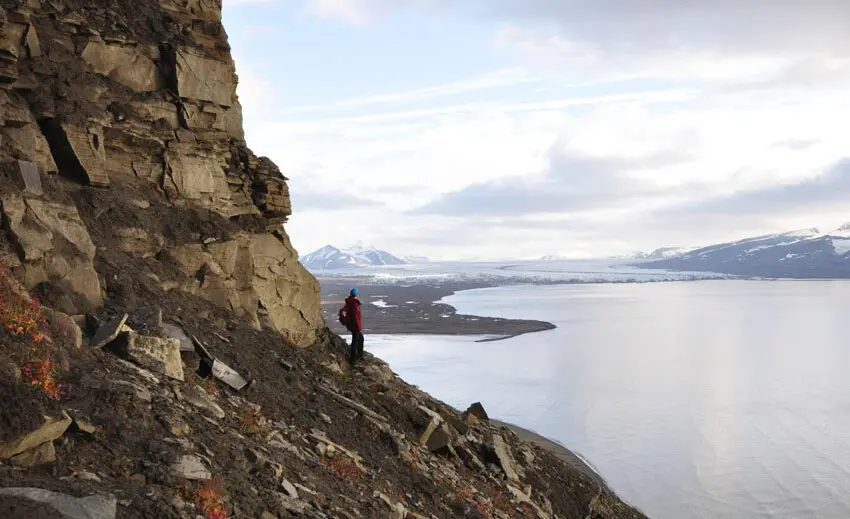Triassic development of the Norwegian Barents shelf

AG-323/823 fieldwork in Van Keulenfjorden. Photo: Robert Pfau/UNIS.
Top image: Geology fieldwork on Spitsbergen. Photo: Robert Pfau/UNIS
Mark Mulrooney has studied the Triassic development of the Norwegian Barents shelf using case studies from the Hammerfest Basin (offshore) and Svalbard (onshore). Mulrooney will defend his PhD thesis Wednesday 21 March at the University of Oslo.
15 March 2018
Press release from the University of Oslo and the University Centre in Svalbard (UNIS)
The Triassic successions represent large deltaic systems that are partly sandstone prone, and envisaged to host significant undiscovered hydrocarbon resources. Further, the distal parts of these successions onshore Svalbard are being appraised for potential CO2 storage. The study attempts to bridge some of the knowledge gaps that exists in respect to the Triassic evolution of the Barents shelf, in particular, Late Triassic extensional tectonism is investigated, the driving mechanisms and styles of this faulting, and how the faulting affects the distribution and petrophysical properties of reservoir quality sandstones.
Seismic and outcrop based studies show that the Triassic Barents shelf was more tectonically active than previously described. Offshore, multi-azimuth seismic investigations highlight a previously undocumented phase of Norian to Rhaetian extension in the Hammerfest Basin, which is possibly linked to a phase of rejuvenation of Fennoscandia to the south. Onshore investigations of growth faults in Late Triassic deltaic successions on Edgeøya, Eastern Svalbard highlight the importance of slope attitude, diagenesis, and compaction on the style/mechanisms of faulting and the subsequent petrophyical properties of damage zones.
PhD defense
Mark Mulrooney will defend his thesis entitled “Faults affecting the Triassic Barents Shelf: Syn-kinematic deposition, deformation mechanisms and driving forces” on Wednesday 21 March at 13:15. He will give a trial lecture entitled: “Gravity driven growth faults: from the outcrop to the seismic scale, with examples from the Gulf of Mexico and the Niger Delta” at 10:15 the same day. Both lectures will take place in Auditorium 1, the Geology Building, the University of Oslo.
The committee consists of Professor John Howell (School of Geosciences, University of Aberdeen), Professor Emeritus John A. Korstgård (Department of Geoscience, Aarhus University) and Professor François Renard (Department of Geosciences, University of Oslo). The disputation will be led by Professor Annik M. Myhre.
Supervisors have been Professor Alvar Braathen (Department of Geosciences, University of Oslo), Professor Snorre Olaussen (The University Centre in Svalbard), and Professor Jan Inge Faleide (Department of Geosciences, University of Oslo).
About the candidate
Mark Mulrooney comes from Ireland and has a Bachelors (Hons) degree in Geology from University College Dublin (2009) and a Master’s degree in Petroleum Geoscience from Royal Holloway, University of London (2011). Mark was employed as a PhD candidate at UNIS from 2013 to 2017, and now works as a researcher at the University of Oslo.
E-mail: mark.mulrooney@geo.uio.no
